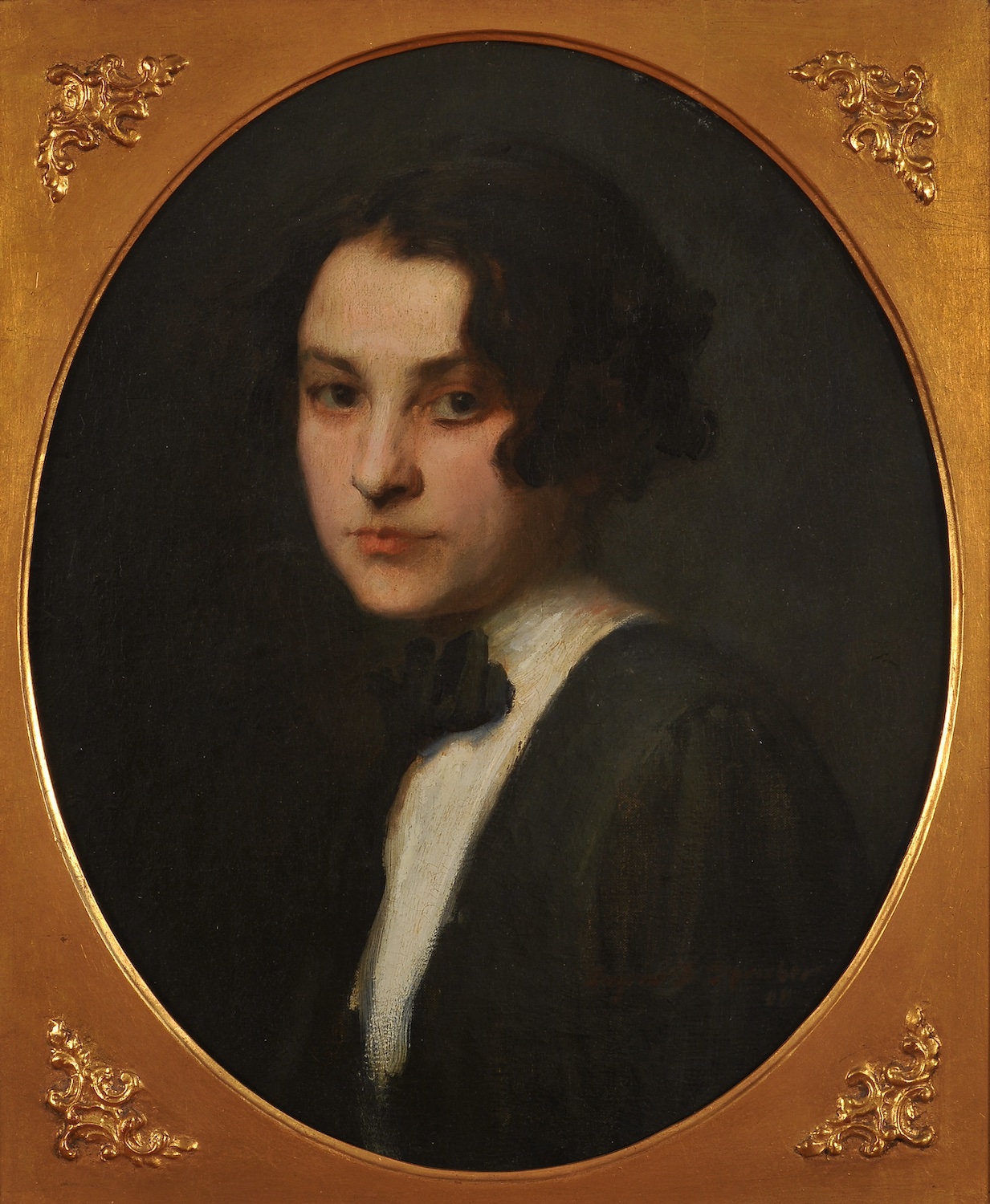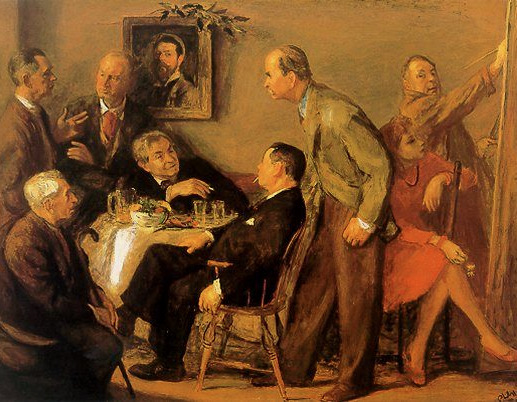
Two students met in a stairwell at the Art Students League of New York. This is neither the beginning of a joke, a romantic tryst, nor the origin of a movement. It is, in Georgia O’Keeffe’s telling, a story of misogyny, and a prelude to two careers that would serve as examples of distinctive responses by representational artists to twentieth-century modernism. It was 1908.
“Eugene Speicher,” O’Keeffe recalled, “was one of the older students at the League and a very handsome young man. He often stopped me and wanted me to pose for him. Speicher wanted to paint me—but I wanted to work myself. One morning as I climbed to the top floor for the Life Class, there he sat with his fresh linen smock, blocking the whole stairway and threatening that he would not let me pass unless I promised to pose for him. I was annoyed and wanted to go up to work.
“‘It doesn’t matter what you do,’ he said, ‘I’m going to be a great painter and you will probably end up teaching painting in some girls’ school.’ I insisted on passing and he remarked, ‘I’ll give you the painting if you pose for me.’ Finally he let me go, and I went down the dark hall to the Life Class. The model happened to be a very repulsive man who gave me the creeps, so I gave up and went back to Speicher. He worked very quickly and the portrait was soon finished—probably because he had it so clear in his mind when he started.”
O’Keeffe recounted an atmosphere exasperatingly familiar to women, and not only to those in the arts. A young student caught between a rock and a hard place, she acceded to the will of a colleague in the face of a worse alternative. Though O’Keeffe never says so overtly, the story carries an implicit predatory undertone. The portrait exists apart from this narrative. Something of O’Keeffe’s independent character comes through the painting’s atmospheric delicacy. It must have been this quality Speicher was intent on capturing. “I’ve been a person,” O’Keeffe said much later, “other people always wanted to paint or photograph.”
It is not easy to find information about Speicher’s life before he attended the League. A monograph accompanying a museum retrospective in 2014 skips the painter’s first twenty-five years and begins his biography with the O’Keefe portrait. Perhaps the best biographical source is the December 1936 issue of Esquire magazine, wherein a rambling profile emphasized his financial success to support the declaration that Speicher was “America’s most important living painter.” (That assertion required a sprightly pirouette to dance around not only O’Keeffe, but Edward Hopper, Marsden Hartley, the Regionalists, Stuart Davis and Charles Demuth). We learn that Speicher was born in Buffalo in 1883, of German ancestry. He was a star athlete in high school, and afterwards considered becoming a lumberman before abruptly changing course to study art. Speicher arrived at the League in the fall of 1907 and studied with William Merritt Chase and Frank Vincent DuMond. In 1909 he began studying with Robert Henri and took Kenyon Cox’s old studio. He moved to Woodstock, New York, and eventually became successful enough as a portrait artist that he stopped accepting commissions and painted who and what he pleased.
Like many American artists of his generation, Speicher was impacted by the 1913 Armory Show. Speicher was successful with a representational vernacular that acknowledged French modernism; the influence of Renoir was seen in the work of many American artists of the period. A 1934 gallery exhibition of his work outdrew an Edward Hopper retrospective at the Museum of Modern Art of the previous year. When it came, the popular reversal was dramatic. Fashions changed after the Second World War and museums deaccessioned his paintings as quickly as they’d once sought them. Speicher’s art has not transcended its era well, and perhaps his canvases will claim a measure of historical value for their limitations, his figures caught in the amber of a bygone style.
Georgia O’Keeffe was born in a Wisconsin farmhouse in 1887. She studied with John Vanderpoel at the Art Institute of Chicago from 1905 to 1906, lost a year to typhoid fever, and enrolled at the League in 1907, studying with Kenyon Cox, F. Luis Mora, and Chase. Presaging her later choice of subjects, O’Keeffe preferred still life to figure studies:
The Chase Still Life Class was much more fun. Every day we all had to paint a new still life. Then once a week William Merritt Chase came in to criticize. As soon as he arrived in the office downstairs everyone in the building knew it and we all got out our five or six canvases to be criticized. He wore a high silk hat, rather tight fine brown suit, light colored spats and gloves, a carnation in his lapel. He had a beard and moustache and glasses on a cord. There was something fresh and energetic and fierce and exacting about him that made him fun. His love of style—color—paint as paint—was lively. I loved the color in the brass and copper pots and pans, peppers, onions, and other things we painted for him. The slick canvases had eight or ten paintings—painted one on top of the other as the weeks went by. To interest him, the painting had to be alive with paint and a kind of dash and ‘go’ that kept us looking for something lively, kept us pretty well keyed up.

Dead Rabbit with Copper Pot doesn’t feature the ostentatious surfaces one might expect from O’Keeffe’s description of class. The pot is muted, the atmosphere subtle. Like Speicher’s portrait, it is reminiscent of 19th century practices. Both rabbit and pot are placed near the top of the canvas; the inventiveness of the composition was recognized by the school, which awarded O’Keeffe a scholarship to its summer program in Lake George. Short of funds, O’Keeffe left New York, stopped painting for four years and began instructing—Speicher’s arrogance seemed prescient.
While studying in Virginia, O’Keeffe became acquainted with the teachings of Arthur Wesley Dow, who had instructed at the League before O’Keeffe’s arrival there. She returned to New York and studied with him at Columbia University in 1914, affirming her move toward abstraction. Alfred Stieglitz, whom O’Keeffe later married, exhibited her work and encouraged her to paint in oils rather than watercolor. In the 1920s, she painted her series of large flowers, as well as several New York cityscapes. O’Keeffe first visited New Mexico in the late twenties, and would eventually make it her home, focusing on the landscape and indigenous still life elements. In the decades to follow she was the subject of numerous museum shows, and became known as the ‘godmother’ of American modernism. She received the Presidential Medal of Freedom in 1977.
The sharp-edged iconography of O’Keeffe’s irises and animal skulls is far removed from the sfumato of Dead Rabbit with Copper Pot, the contrasting idioms of an artist born in the nineteenth century who came to maturity well into the twentieth. Nevertheless, her student work evidences an interest in design and what was to be a lifelong genius for paring a subject to its visual—and less definably but just as recognizably—spiritual essentials. Just as her mature work suggests the clear vast spaces of her adopted West, a student still life exemplifies the dim natural light of a New York studio, and brings a host of sensual associations for those of us who have painted there.
There is a postscript to O’Keeffe’s interaction with Speicher at the League. Six years later, when she returned to New York in 1914, she received a letter. “My dear Miss O’Keeffe—Will you call me up on the telephone Bryant 105? I want to paint your portrait and will give it to you after I exhibit it. Yours truly, Eugene Speicher.” We don’t know if she responded. But O’Keeffe kept the letter the rest of her life, and it was discovered only after her death in 1986.
JERRY WEISS (@jerrynweiss) teaches drawing and painting at the Art Students League of New York.




